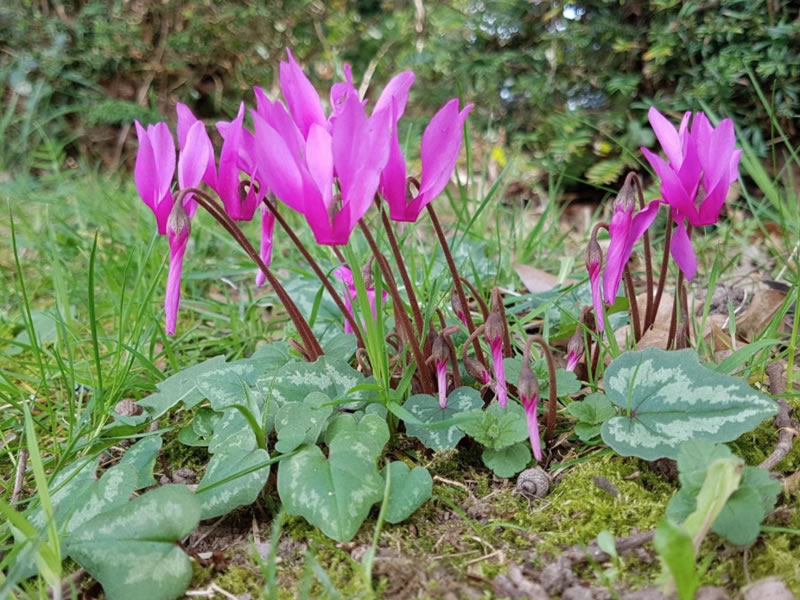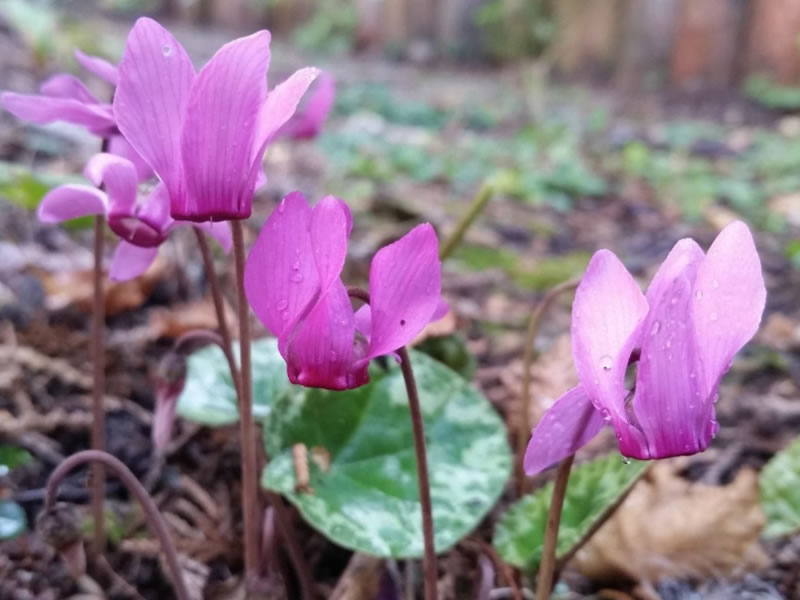Quentin Stark who is the Plant Doctor at the Plant Fair Roadshows events has written this article about one of his favourite plants.
There are over twenty species of Cyclamen, growing across Southern Europe, West Asia and Northern Africa.
I was introduced to the tender florist Cyclamen persicum as a young boy by my mother. It wasn’t until I was working at Savill Gardens I met the charming hardy species in the woodland garden. I was lucky to move to my current job which was five minutes from the former specialist Cyclamen nursery Tile Barn. The nearest thing to Cyclamen heaven.
It is some of these hardy species that I want to mention next.

Cyclamen repandum one of the lesser known species and is defiantly a woodland plant, as its foliage is less leathery than its cousins Cyclamen hederifolium and C. coum. Its leaves have a well-defined hastate pattern outlined in silver. The foliage comes up in spring with the arrival of warmer days to come, followed soon by the long elegant slightly twisting magenta petals.

This Cyclamen is more of a challenge to grow well out in the garden, as it prefers a continental climate. It is worth trying by planting deeply in a humus shady spot, as this species flowers from June to October with pale pink to carmine and rarely white flowers with the most delightful sweet scent like violets, the best scent of any Cyclamen. It is in leaf almost all year around with heart to kidney shaped leaves that vary in colour from glossy green to entirely pewter coloured, usually has a hastate pattern highlighted in cream, silver or pewter

To me the end of hazy days of summer and the coming mellow fruitfulness of Autumn is signified with the appearance with the first blooms of the most accommodating and long-lived Cyclamen species.
Cyclamen hederifolium is one of the most common species grown, with its butterfly-like blooms that come in shades of rose-pink or white before the leaves, make their appearance. The foliage gives an added bonus to the beauty and another reason to grow these small hardy plants. These leathery leaves with hastate mark in the centre of the leaf, and marbled with shades of green, pewter and silver give rise to almost limitless patterns.

These pictures show the bank opposite my back door, on which Cyclamen hederifolium has appeared over the last 18 years and I’ve not planted one of them, so how did they come to be there?

The seeds of Cyclamen have a sweet coating on them and this is desirable to mice and ants. They collected the seeds from plants in other parts of my garden removed the sweet coating and left the seeds in their runs which seems to be a great place for germination.
Cyclamen coum arrives in winter it’s kidney shaped leaves fully expanded. These leaves like the autumn flowering hederifolium have a central hastate marking and can be as variable as Cyclamen hederifolium. The flowers are dumpy compared to other species of Cyclamen, I think this gives them a charm of their own. This delightful species starts to flower in December and continues well into February, with a range of colour from pure white through hints and shades of pink to carmine. This is my favourite species as it gives the most welcome colour in the depth of winter.

To find out more about these wonderful charming plants, the book by Christopher Grey-Wilson, Cyclamen A guide for gardeners, horticulturists and botanists. It has everything you need to know about growing Cyclamen.
The Cyclamen society is great to group to join to further your knowledge and increase your plants through their seed scheme.
‘’I know of no other genus whose plants flower out of doors every day of the year. I know of no other genus with one or more species coming into bloom or growth, peaking or going dormant at every season.
Nancy Goodwin
Victoria Mummery
Plant Fairs Roadshow
1 Beechbridge Cottages
Goudhurst Road
Marden
TN12 9NN